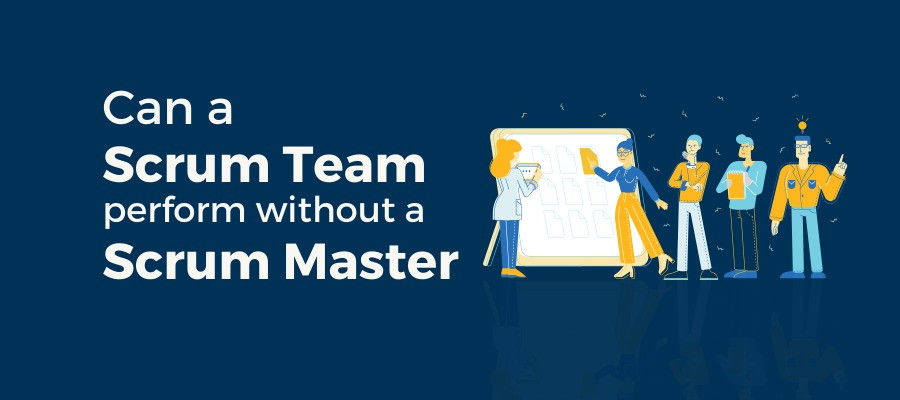Can a Scrum Team perform without a Scrum Master?

It often feels like each time during the new project, one of the earliest and most challenging discussions revolves around the necessity of having a full-time, dedicated Scrum Master for each Agile Team. Two key factors primarily drive this recurrent conversation. First, the organizations ponder whether Scrum Masters will be sustainably required after the Scrum teams become more independent and self-managing. Second, and just as likely, there might be some uncertainty about the precise role and value a Scrum Master brings to the table.
In this blog post, we aim to provide a crystal-clear understanding of the pivotal role played by Scrum Masters. We'll explore whether your team really need a dedicated Scrum Master or if other approaches can be equally effective.
What Is the Role of a Scrum Master?
A Scrum Master serves several key purposes, with the following being the most prominent:
Coaching Team Members on Agile Principles: The Scrum Master guides and instructs team members in understanding and applying Agile Principles.
Ensuring Team Productivity: The Scrum Master plays a crucial role in enhancing team productivity by removing obstacles and addressing internal conflicts.
Facilitating Scrum Events: They also facilitate Scrum Events and other important meetings within the team.
Removing Impediments: The Scrum Master removes impediments faced by the Scrum team so they can work more seamlessly.
Why do we need a dedicated Scrum Master?
One of the most crucial contributions of having a dedicated Scrum Master is the profound impact they have on the Agile Team's comprehension of the new work methodology. When a newly formed Agile Team encounters various events and artifacts within the Scrum framework, many of these concepts may seem unfamiliar and even appear wasteful or devoid of meaning without proper context. In the early days, as well as time progresses and the team's initial training begins to fade from memory, the Scrum Master assumes the role of a teacher, guiding the team in discovering the intrinsic value of this way of working. They help to deeply understand and appreciate the Scrum framework – the accountabilities, events and artifacts.
It's essential to remember that when teams face challenging situations and impediments, they are, after all, human. Under pressure, they may swiftly revert to their previous, more familiar work practices. In such moments, the presence of a dedicated Scrum Master becomes especially valuable as they continue to reinforce the team's understanding of Agile Principles and help them stay aligned with this transformative approach.
Ultimately, one could argue that the primary goal of a Scrum Master is to help the team become self-managing, reducing the need for a Scrum Master over time. Consequently, not every team requires one to the same extent, and their necessity may diminish with increased team maturity.
It's important to note that a Scrum Master is not a specific person but rather a role that can be fulfilled by someone other than a dedicated Scrum Master. There are three main approaches to addressing the absence of a dedicated Scrum Master:
The concept of having a coach is not a novel one. Even the most matured Agile Teams recognize the value of having full-time Scrum Masters when they are operating at their peak performance. This is because achieving greatness demands it. Agile Teams are no exception; they thrive when they have a dedicated Scrum Master Coaching them to enhance their collaborative efforts and consistently deliver value.
In addition, once the teams become self-managing, the Scrum Master should coach other teams, other Scrum Masters, other Product Owners, customers, middle level managers, customers, users, senior leadership teams etc. Scrum Master is a change agent for the organization.
Agile Teams Without a Scrum Master
While not ideal for most teams, mature teams well-versed in Agile product development, especially Scrum, can attempt functioning without a Scrum Master. This is possible only if teams are able to resolve impediments and delivering value independently. However, this may not hold good for a long time because the Scrum team will slip into a chaotic situation if the impediments are not resolved in a timely manner.
If not Scrum Masters, Who else?
The responsibilities of a Scrum Master can be transferred to several related roles within an organization. In many instances, individuals in positions such as Project Managers, Program Managers, Engineering Managers, Quality Assurance team members, and others have taken on some or all of these responsibilities.
Recent job descriptions from various industries consistently reflect this trend. While the titles may differ, they all encompass some degree of responsibility that was traditionally associated with the Scrum Master role. Here are a few examples of titles that often have these responsibilities:
- Agile Project Manager
- Agile Coach
- Agility Lead
- Agile Program Manager
- Agile Delivery Lead
So irrespective of the title, the Scrum Master as an accountability is still a necessity for Agile teams for consistent performance and delivering value to the business teams.
Conclusion - Can a Scrum Team perform without a Scrum Master?
Simply No. The Scrum Master's role primarily involves two key aspects – removing impediments and serving as the process champion. As the team becomes self-managed, the need for a dedicated process champion may diminish, but the role of impediment removal remains crucial.
So, while it's possible to function without a Scrum Master, achieving optimal productivity and delivering a high-quality "Potentially releasable" product Increment at the end of each Sprint often necessitates a dedicated Scrum Master.
Pro tip: If you find that having a Scrum Master for each team is burdensome, one approach is to assign a Scrum Master to work with 2 or 3 Scrum teams. Beyond this threshold, the effectiveness of the Scrum Master may be compromised.
Ref links:



